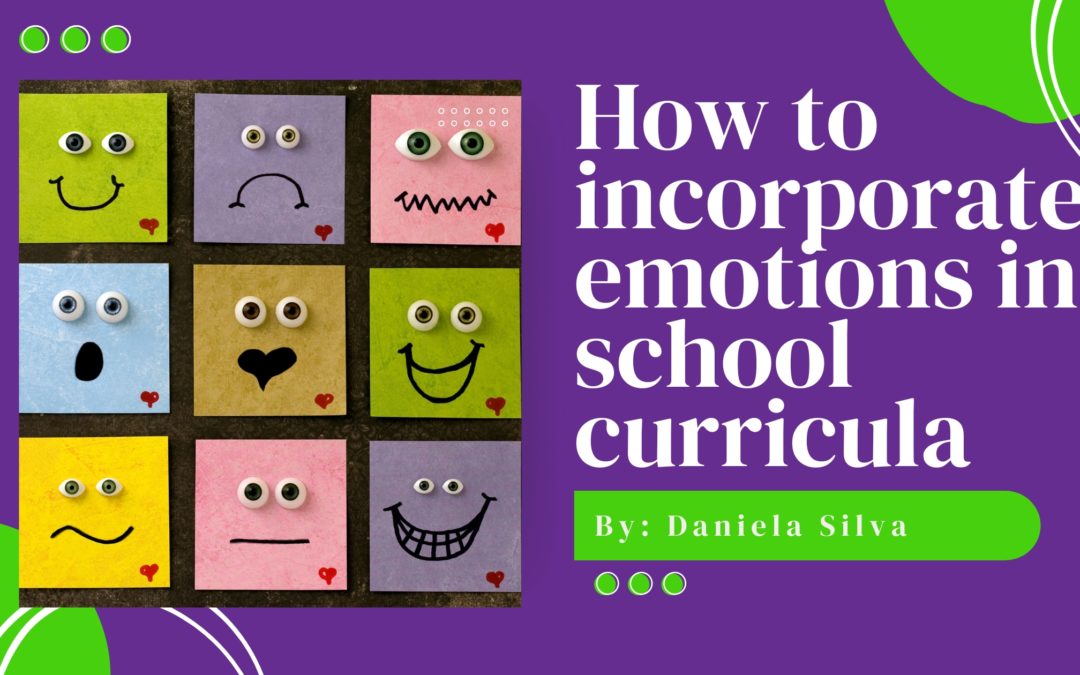How to incorporate emotions in school curricula.
By: Daniela Silva
Have you ever heard of Emotional Pedagogy?
It refers to an educational approach that recognizes the importance of emotions in the learning process. It focuses on understanding and addressing the emotional needs of students to create a positive and supportive learning environment.
But how do we incorporate this into the school curriculum in a practical and effective way?
Incorporating emotions into school curricula is essential for fostering students’ social and emotional development, improving their well-being, and enhancing their overall learning experience. Here are some strategies to do so:
Emotional Expression:
Providing opportunities for students to express their feelings through various forms of communication, such as discussions, art, or writing. In my book “Developing the Creative Potential of Children: by Stimulating the Windows of Opportunity“, I give an example of an activity where children are encouraged to develop a collage on the theme “What do I value most in life?”. In this activity, self-awareness skills about one’s values and beliefs are emphasized.
Emotional Awareness:
Encouraging students to recognize and express their emotions in a healthy and constructive manner. Teach children to identify and label their emotions. Use simple words to describe feelings such as happy, sad, angry, scared, etc. You can do this by asking them how they feel in various situations or by using free printable emoji cards for noticing, naming, understanding, and sharing emotions.
Read Emotions in Others:
Help children understand that people express their emotions through facial expressions, body language, and tone of voice. Play games where you discuss and guess the emotions of characters in stories or TV shows.
Practice Mindfulness:
Teach children to pay attention to their feelings in the present moment without judgment. Simple mindfulness exercises like deep breathing or body scans can help them become more aware of their emotions.
Emotion Charades:
Play a game of charades where your child acts out an emotion and the family guesses what it is. This can make learning about emotions fun and engaging.
Empathy Activities:
Engage in activities that promote empathy, such as volunteering or helping others. This helps children connect with the emotions of others and understand different perspectives.
Reflective Writing Activities:
Ask students to write journals, letters, or essays about their experiences, thoughts, and emotions related to the lesson content.
Teacher Training:
Provide professional development opportunities for teachers to understand emotions, emotional intelligence, and strategies to incorporate them effectively into their teaching practices.
Why is Emotional Education in the School Curriculum important?
Integrating emotions into curricula is important for several reasons, as emotions play a significant role in the learning and development of students. Here are some key reasons why incorporating emotions into education matters.
Well-Being and Mental Health:
Recognizing and addressing emotions in education can positively impact students’ mental health and well-being. By creating a safe space for students to discuss their emotions, educators can help reduce stress, anxiety, and feelings of isolation.
Real-World Relevance:
Emotions are an integral part of human experiences and integrating them into curricula makes education more relevant to students’ lives. By discussing real-world situations that evoke emotions, students can better understand the complexities of human behavior and society.
Preparation for Life Skills:
Emotional intelligence is a valuable life skill that can impact future success in both personal and professional realms. Integrating emotions into education helps students develop emotional intelligence, which includes self-awareness, self-regulation, and effective communication.
Reducing Bullying and Negative Behavior:
By promoting empathy and emotional understanding, schools can help reduce bullying and other negative behavior. Students who understand the emotions of others are less likely to engage in aggressive behavior.
Creating a Positive Environment:
An approach that values emotions create a more positive and nurturing learning environment. This can contribute to student engagement, improve classroom dynamics, and increase motivation to learn.
The human being is a social and affective person; that is, there is a need for him/her to establish relationships as well as to feel loved and cherished by society, friends, or family. In the school environment, it could not be different: we learn when we feel good about ourselves and with those around us, such as teachers, friends, administrators, and school staff.
Emotional intelligence is a skill that allows people to learn to manage their own emotions (through self-knowledge), understanding not only their own limits but also the limits of others. The ability to manage your own emotions can contribute to the development of healthy relationships and decision-making skills, both in academic and professional life.
Integrating emotional intelligence into curricula equips individuals with crucial life skills that extend beyond traditional academic knowledge. It prepares them to navigate complex social dynamics, contribute positively to their communities, and thrive in various aspects of their lives.
Overall, incorporating emotions into the school curriculum not only enriches students’ educational experience, but also prepares them for a balanced, healthy, and successful life in all respects.
OTHER WAYS TO CONNECT
We hope you enjoyed these ideas about how you can get your children back in the mindset for school. What are your thoughts on the subject? Please connect with us on Facebook and Instagram and let us know!
If you would like to learn more about upcoming events, sign up to receive our quarterly newsletter here.
Check out some of our other blog posts here, for tips and tricks for single parents, budget hacks, inspiration and more information about what we do here at SPARC Hope.
AUTHOR BIO
Daniela Silva is a Brazilian Education and Mental Health Writer living with her husband in Goiânia (GO), Brazil. She holds a BA in Pedagogy; an MBA in Personnel Management and a postgraduate certificate in Neuroeducation. Working as an educational writer since 2012, Ms. Silva is a regular contributor to several educational websites, such as oc87 recovery diaries, The Ability Toolbox, 4W, Inspire the Mind, Psychreg, The Old Schoolhouse Magazine, New Heights Educational Group, and Texas Homeschool Coalition.

